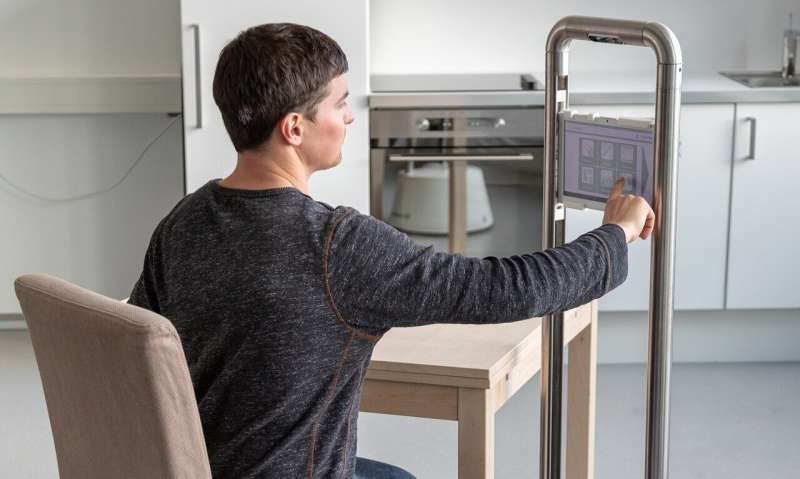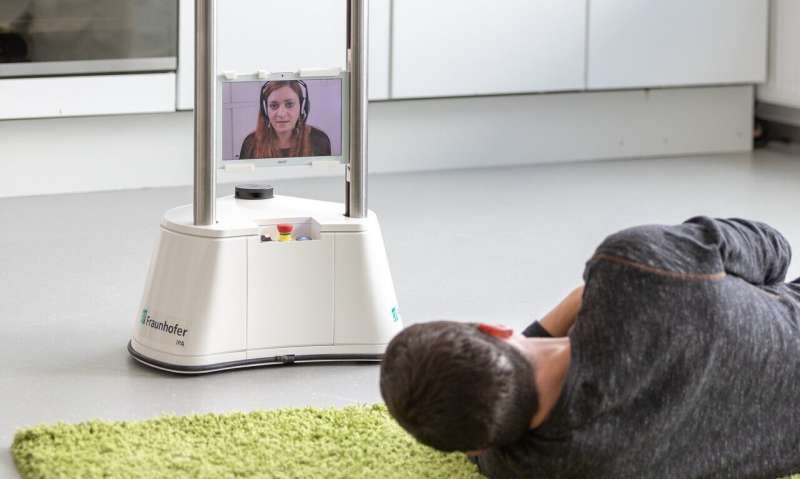May 23, 2019 feature
MobiKa: A low-cost mobile robot that can assist people in a variety of settings

Researchers at Fraunhofer IPA, in Stuttgart, Germany, have recently developed MobiKa, a low-cost, mobile robot capable of two-modal (voice and text) interactions with humans. Their robot, presented in a paper pre-published on arXiv, could be particularly useful for assisting elderly people.
Recent advances in robotics have enabled the development of robots that can assist humans both in their homes and in healthcare settings. These robots could help a number of people, including the elderly, by assisting them with daily tasks, reminding them to take medication or administering basic treatments.
"The history of mobile robots for healthcare at Fraunhofer IPA reaches over 20 years in the past," Florenz Graf, a research associate at Fraunhofer IPA who carried out the study, told TechXplore. "An example is the service robot Care-O-bot, which has been a product vision and demonstrator since 1998. It is now available in its fourth generation, and is already serving as a shopping assistant in electronics stores. Our current goal is to transfer the developed technologies to specialized and thus more cost-effective platforms."
By shifting their focus to more specialized platforms, Graf and his colleagues were able to develop a more affordable robot that is based on new software technologies, such as navigation tools. In their recent publicly funded project, the researchers introduced a prototype of MobiKa in a real-world health care setting and evaluated its interactions with elderly people.
"MobiKa is a service robot for use at home or in care facilities, which is currently available as a prototype," Graf explained. "The robot consists of a mobile, wheel-driven platform and a slim height-adjustable tablet on top. Using navigation software developed here at Fraunhofer IPA, MobiKa moves safely and autonomously to a given destination."

The mobile robot can navigate autonomously in dynamic and changing environments. It is also able to identify and approach individual people using person recognition software and an algorithm to calculate the poses of approaching humans. MobiKa can communicate with people in two ways: by generating text on a tablet or via voice responses.
"It was particularly important to us that the robot could be used economically," Graf said. "Therefore, we integrated components that are as simple and cost-effective as possible. In contrast to other interaction robots, we designed MobiKa in a functional and deliberately non-humanoid way. This allows underlining its function as a tool for the user, comparable to existing household appliances or robots."
After evaluating MobiKa in a laboratory setting, the researchers tested it in a care home for elderly people with dementia. These tests allowed them to gain a better understanding of how the robot is perceived by users and identify areas that could be improved.
"Not only did we discuss the application in detail with end user representatives," Graf said. "We also conducted practical tests in an elderly care home where MobiKa successfully interacted with a number of seniors for some hours over multiple weeks. MobiKa's functional design helped us to achieve a high level of acceptance, because elderly people also see it as a supplement, rather than as a replacement to humans. Another important finding of our study was that human-robot interaction needs personalization as well as updates to maintain the interest of users over longer periods in time."
Although the researchers have so far only tested MobiKa in a care facility for the elderly, it could soon be applied and evaluated in a variety of other settings. For instance, the researchers are planning to hand out MobiKa to other research institutes, so they can use it in their own projects. Meanwhile, they are also seeking companies that interested in developing the robot on a larger scale and getting it ready for production.
"We have additional ideas for further development," Graf added. "With the integration of object recognition software, the robot could be used to find articles that a user misplaced in his/her home. We could also attach an additional shelf to the robot, which would allow it to help users with limited mobility to transport everyday objects and thus support their independence at home."
More information: Florenz Graf, et al. MobiKa- Low-cost mobile robot for human-robot interaction. arXiv:1905.01065 [cs.RO]. arxiv.org/abs/1905.01065
© 2019 Science X Network





















